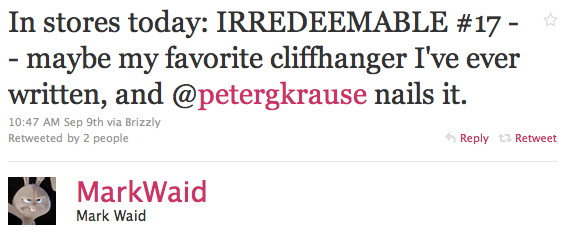Actually not this week’s haul (which came out today), but the last two weeks’ hauls. You know how it goes…
Two Weeks Ago:
- American Vampire #7, by Scott Snyder & Rafael Albuquerque (DC/Vertigo)
- Madame Xanadu #27, by Matt Wagner & Celia Calle (DC/Vertigo)
- Secret Six #26, by Gail Simone & Jim Calafiore (DC)
- Tom Strong and the Robots of Doom #5 of 6, by Peter Hogan, Chris Sprouse & Karl Story (DC/America’s Best Comics)
- Captain America: Forever Allies #3 of 4, by Roger Stern, Nick Dragotta & Marco Santucci (Marvel)
- S.H.I.E.L.D. #4, by Jonathan Hickman & Dustin Weaver (Marvel)
- Incorruptible #10, by Mark Waid, Horacio Domingues, Juan Castro & Michael Babinski (Boom)
- The Boys #47, by Garth Ennis & Russ Braun (Dynamite)
Last Week:
- Batman: The Return of Bruce Wayne #5 of 6, by Grant Morrison, Ryan Sook, Pere Pérez & Mick Gray (DC)
- Green Lantern #58, by Geoff Johns, Doug Mahnke & Christian Alamy (DC)
- Green Lantern: Emerald Warriors #3, by Peter J. Tomasi, Fernando Pasarin & Cam Smith (DC)
- Knight & Squire #1 of 6, by Paul Cornell & Jimmy Broxton (DC)
- Superman #703, by J. Michael Straczynski, Eddy Barrows & J.P. Mayer (DC)
- The Unwritten #18, by Mike Carey & Peter Gross (DC/Vertigo)
- Victorian Undead: Sherlock Holmes vs. Jeckyll/Hyde special, by Ian Edginton & Horacio Domingues (DC/Wildstorm)
- Casanova #4, by Matt Fraction & Gabriel Bá (Marvel/Icon)
- Echo #25, by Terry Moore (Abstract)
- Irredeemable #18, by Mark Waid & Peter Krause (Boom)

|
I’m not entirely sure what to make of Paul Cornell. He’s a very inventive writer, but his plotting is rather scattershot, and more portentous than meaningful. I had this feeling when I read his novel Something More, and the first episode of Doctor Who he wrote, “Father’s Day” (though he did get the emotional center of that one right, even if the story didn’t make a lot of sense). His current run on Action Comics is in a similar vein. In a way he seems like Grant Morrison lite: An idea man, but his execution can feel haphazard and unsatisfying.
In fact, he’s picking up a couple of Grant Morrison creations in this new mini-series, Knight and Squire (okay, they first appeared in the silver age, but Morrison basically recreated them from whole cloth, since it’s not like “the English Batman and Robin” is a concept with legs all by itself), and Cornell reintroduces them here in a pub where heroes and villains gather to hang out, compelled by the magic of the place not to fight. It’s not a bad idea, but it’s an awkward way to introduce the main characters, throwing them into an Alan-Moore-esque “let’s introduce a hodge-podge of British heroes and villains all at once” story, characters that the reader really has no investment in. It’s more of a neat concept than a story – which again feels very Morrison-like. So, it’s an okay beginning, but felt kind of inconsequential. Broxton’s art is nice, sort of Alan Davis crossed with Ed McGuinness. If this series is just going to be six cute vignettes, though, then I think it’ll be a disappointment. Hopefully Cornell’s got something larger planned, and something that focuses on the main characters. |
 
|
Last month Mark Waid tweeted:
While it was a pretty good cliffhanger, honestly I’d kind of seen it coming. Partly as a result, I think both of Waid’s cliffhangers in this month’s books are better than that one: Incorruptible sees our villain-turned-hero and new sidekick rescuing (after a fashion) the Plutonian’s former girlfriend, and learning what her captors had planned – a plan which they apparently execute on the last page. Irredeemable builds a new plot thread out of whole cloth – plausibly, since it revolves around the world’s Batman-type character – with truly world-changing consequences (even by the standards of a Superman figure turned evil) on the final page. Irredeemable has been consistently solid, but it felt like it was marking time until artist Peter Krause returned, and now it’s kicking into high gear. Incorruptible has been thrashing a bit, trying to find its voice and purpose (and it hasn’t really done so yet), being somewhat overwhelmed by the events in its companion title that the main character hasn’t really had much of a chance to shine, but it’s still got some good stuff, and I think it still has a good chance to improve – I’m just not quite sure what I want to see it do that would make it better. I think I’d like more of a focus on Max and the implications of his decision to turn good, since so far it mostly seems like a lot of adventuring and those implications are dealt with almost incidentally. |








